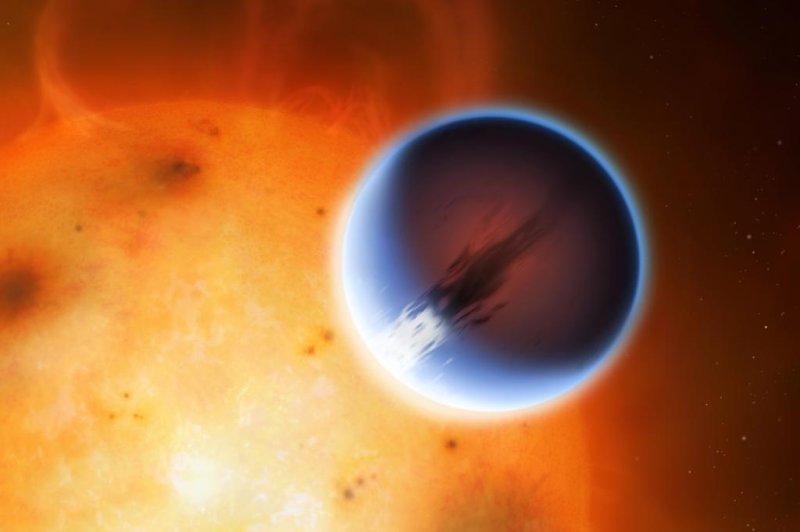The day side of the exoplanet likely looks blue, as light becomes scattered from the atmosphere's silicate haze. The planet's high temperature causes the night side to glow a deep red. Photo by Mark A. Garlick/University of Warwick
COVENTRY, England, Nov. 13 (UPI) -- Scientists at the University of Warwick in England have built the first weather map of a planet outside our solar system. The exoplanet hosts winds measuring upwards of 5,400 miles per hour.
"Whilst we have previously known of wind on exoplanets, we have never before been able to directly measure and map a weather system," Tom Louden, Warwick astrophysicist and lead researcher on the project, said in a press release.
The exoplanet is HD 189733b, a hot Jupiter-like world that lies 63 light-years away in the constellation Vulpecula, the Fox.
The combination of spectroscopy and the scientists' understanding of the Doppler Effect made it possible to measure the velocity of winds in the faraway planet's atmosphere.
Using the High Accuracy Radial Velocity Planet Searcher, a telescope in La Silla, Chile, researchers were able to detail the exoplanet's atmosphere by plotting sodium atoms' absorption of the host star's radiation -- that's the spectroscopy part.
By analyzing the way these spectroscopy results changed as the planet moved across the face of its sun -- its atmosphere moving away from Earth and towards Earth -- researchers were able to pick up the signatures of the Doppler Effect and ascertain the atmosphere's velocity on both sides of the planet.
"As parts of HD 189733b's atmosphere move towards or away from the Earth the Doppler effect changes the wavelength of this feature, which allows the velocity to be measured," Louden explained.
"The surface of the star is brighter at the center than it is at the edge, so as the planet moves in front of the star the relative amount of light blocked by different parts of the atmosphere changes. For the first time, we've used this information to measure the velocities on opposite sides of the planet independently, which gives us our velocity map."
The map shows the extremely high-powered winds blowing from its day side to its night side. Previous research suggests the exoplanet is tidally locked, with a permanent day and night side. The day side likely looks blue, as light becomes scattered from the atmosphere's silicate haze. The planet's high temperature causes the night side to glow a deep red.
Researchers say their findings, which were published in the Astrophysical Journal, will help astronomers study the atmospheres of other nearby planets, and may even help researchers locate Earth-like planets outside our solar system.
"We are tremendously excited to have found a way to map weather systems on distant planets," said study co-author Peter Wheatley, also an astrophysicist at Warwick. "As we develop the technique further we will be able to study wind flows in increasing detail and make weather maps of smaller planets. Ultimately this technique will allow us to image the weather systems on Earth-like planets. "















